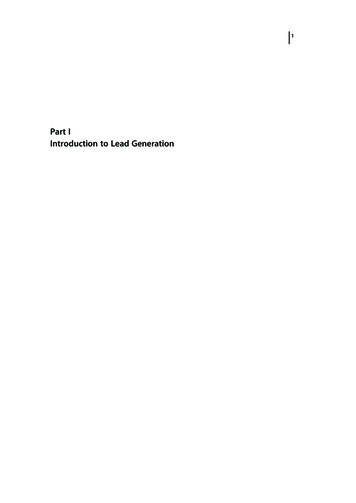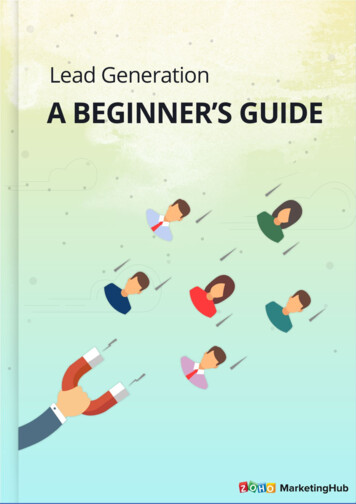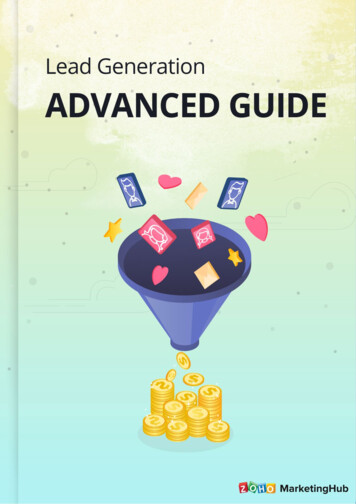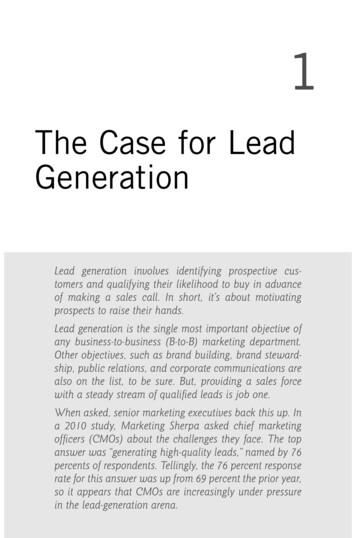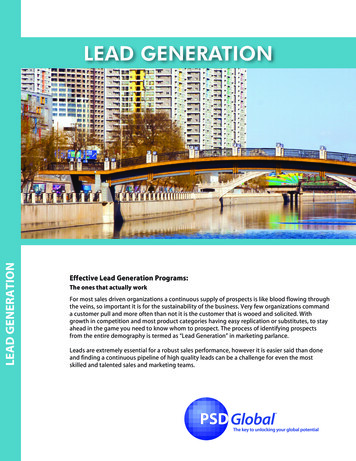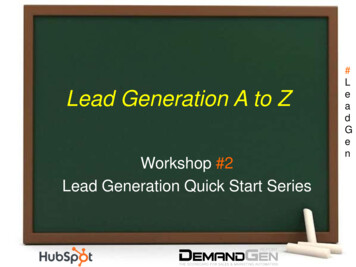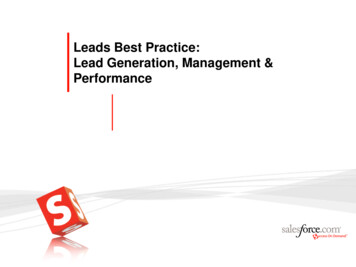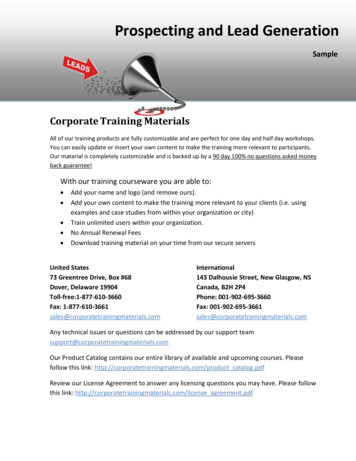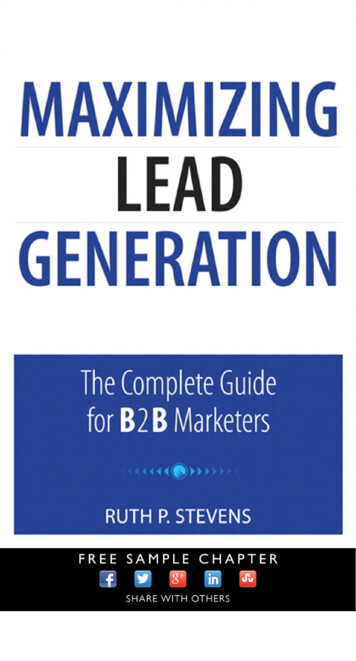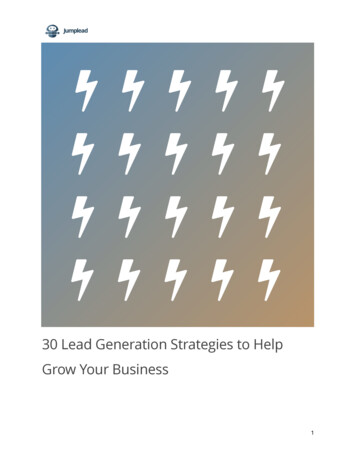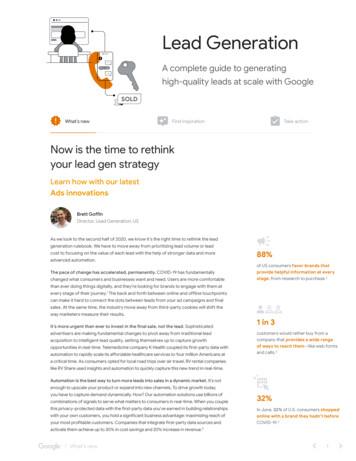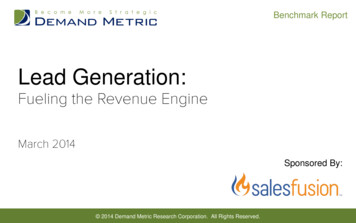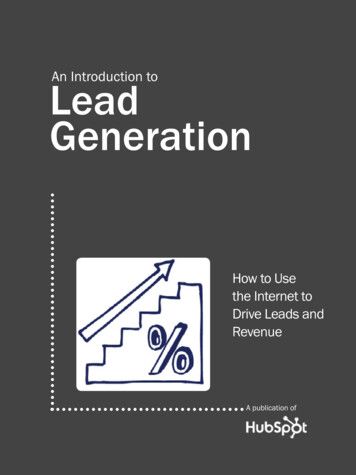
Transcription
1introduction to Lead GenerationAn Introduction toLeadGenerationHow to Usethe Internet toDrive Leads andRevenueA publication ofShare This Ebook!www.Hubspot.com
2introduction to Lead GenerationIS THIS BOOK RIGHT FOR ME?Not quite sure if this ebook is right for you? See the below description to determine ifyour level matches the content you are about to read.INTRODUCTORYThis ebook!Introductory content is for marketers who are new to the subject.This content typically includes step-by-step instructions on howto get started with this aspect of inbound marketing and learn itsfundamentals. After reading it, you will be able to execute basicmarketing tactics related to the topic.INTERMEDIATEIntermediate content is for marketers who are familiar with thesubject but have only basic experience in executing strategies andtactics on the topic. This content typically covers the fundamentalsand moves on to reveal more complex functions and examples.After reading it, you will feel comfortable leading projects with thisaspect of inbound marketing.ADVANCEDAdvanced content is for marketers who are, or want to be, expertson the subject. In it, we walk you through advanced features ofthis aspect of inbound marketing and help you develop completemastery of the subject. After reading it, you will feel ready not onlyShare This Ebook!to execute strategies and tactics, but also to teach others how tobe successful.www.Hubspot.com
3introduction to Lead GenerationAn Introduction toLead GenerationBy Kipp BodnarKipp Bodnar is an Inbound Marketing Strategistat HubSpot. He is co-author of The B2B SocialMedia Book: Become a Marketing Superstarby Generating Leads with Blogging, LinkedIn,Twitter, Facebook, Email, and More (John Wiley& Sons), the definitive guide for B2B marketerswho want to master social media and driveleads.Follow me on twitter@KippBodnarShare This Ebook!www.Hubspot.com
4introduction to Lead GenerationCOntentsDefining a LEad /5The MECHANICS OF INBOUND LEAD GENERATION /8A guide to generating leads with your website25 lead generation best practices /16don’t waste leads /35CONCLUSION AND ADDITIONAL RESOURCES /37Share This Ebook!www.Hubspot.com/13
5introduction to Lead GenerationCHAPTER 1Defining aLeadShare This Ebook!www.Hubspot.com
6“introduction to Lead GenerationHaving a person’s emailaddress doesn’t makethem a lead for yourbusiness.”What is a lead? A lead is a person who has indicatedinterest in your company’s product or service. Online, alead is traditionally defined as a person that completesa landing page. A landing page is a webpage with a formthrough which a person supplies contact and businessinformation in exchange for free information providedby a company, such as an ebook, webinar, productconsultation, or product demonstration.Having only a person’s email address does not makethem a lead for your business. Instead, view that personas a contact. Because they have provided their emailaddress, possibly as a subscription for your blog oremail newsletter, you now have the opportunity to usetargeted and relevant email marketing efforts to convertthis person into a lead.Share This Ebook!www.Hubspot.com
7introduction to Lead GenerationHow Much Informationis Enough?Since information transactions through landing pagesgenerate leads, one of the first questions a marketeris likely to ask is, how much information should I askfor from a person visiting my landing page? This is achallenging question to answer. The more informationyou ask for, especially sensitive information such as a?person’s age or phone number, the lower the likelihoodthat a prospect will complete and submit your form.The knee-jerk reaction to that is to think that you should only ask for a couple ofpieces of information such as name, address and phone number. The problemwith this is that too little information can burden your sales process and makeit difficult for sales and marketing team members to prioritize leads. Thus, thesolution to this problem involves compromising. When planning or updating yourlead generation strategy, talk with your sales team. Ask them what informationthey NEED about leads in order to have a smooth and productive sales process.If certain information isn’t actively being used by either sales or marketing, thendon’t ask for it.This simple compromise can ensure that you get the landing page conversionrates you want and the information that your sales team needs to close deals.Share This Ebook!www.Hubspot.com
8introduction to Lead GenerationThe Mechanicsof Inbound LeadGenerationInbound leads rock. Instead of cold calling or otherforms of sales prospecting, generating leads throughinbound marketing makes your sales team’s job wayeasier. Think about it. If a person is an inbound lead, itmeans that they have visited your website because thatis where they submitted their contact information.!This means that they should have some idea about your business and yourproduct or service. This saves your sales team a ton of time and allows them toestablish credibility and trustworthiness earlier in the communication process.not only do better educated customers make a salesperson’s life easier, but theycan also be happier customers in the long-term because expectations wereproperly set prior to their purchase.When driving leads online, a business needs to have a few key elements inplace. From a tactical perspective, a marketer needs three crucial things to makeinbound lead generation happen.Share This Ebook!www.Hubspot.com
9introduction to Lead Generationmechanics ofLead Generation:1. Landing Pages - A landing page is a websitepage that has one distinct purpose: lead generation. Thispage contains a form that captures contact informationfrom a visitor in exchange for an offer. Check out ourLanding Pages ebook for more information on how to buildawesome landing pages.Share This Ebook!www.Hubspot.com
10introduction to Lead Generationmechanics ofLead Generation:2. Offer - An offer, in the context of lead generation, issome sort of content or product that is of enough valuefor a person to provide contact information in exchangefor access to it. Traditional lead generation offers include:ebooks, whitepapers, webinars, free consultations, andproduct demonstrations.Share This Ebook!www.Hubspot.com
11introduction to Lead Generationmechanics ofLead Generation:3. Call-to-Action - Landing pages and offers areuseless if no one sees them. To send people to a landingpage, you need a call-to-action. Often abbreviated as CTA,a call-to-action is text, an image or button that links directlyto a landing page. Check out our Call-to-Action ebook formore information on how to create and place calls-toaction effectively.Share This Ebook!www.Hubspot.com
12introduction to Lead GenerationLead GenerationExample:Scenario: A person visits your homepage. Then theysee and click a call-to-action on your homepage. The callto-action takes that person to your landing page wherethey see a description of your offer and have the option tocomplete and submit the form on the landing page. Oncethe person submits the form, they receive your offer andyour sales team has a new lead to contact.CTAShare This Ebook!www.Hubspot.comLandingPageOffer
13introduction to Lead GenerationCHAPTER 2A Guide ToGeneratingLeads WithYour WebsiteShare This Ebook!www.Hubspot.com
14introduction to Lead GenerationGenerate LeadsWith Your WebsiteNow that you have a clear understanding of the mechanics needed to generateleads online, there is only one thing missing: traffic. In order for calls-to-action,landing pages, and offers to actually generate leads, people have to see them.You want to make sure that every page of your website contains a relevant call-toaction.Home Page: Your homepage, for example, might have a general product-focusedcall-to-action, since many different stakeholders visit that as the main page of yourwebsite.Product Pages: On more product-focused website pages you should have acall-to-action that is more tailored to that specific product, since someone whois visiting that page is doing so because they have some level of interest in thatspecific offer.Blog: Your blog should be a source of fresh content that is not overtly productpromotional. This type of more general content can attract a wide range of newvisitors through search engines, social media, and other sources. Because yourblog will be the first website page that many of your visitors see, it is importantto use a more general, less product-focused call-to-action that would appeal to awide portion of your target market. These calls-to-action are typically for ebooks,webinars, or other forms of educational content. See our Blogging ebook for adeeper dive into how to generate leads with your business blog.Taking the time to think through your choices of calls-to-action for each of yourwebpages makes a major difference in your visitor-to-lead conversion rate.Share This Ebook!www.Hubspot.com
15introduction to Lead Generation25 Lead GenerationBest Practices:1. Improve Positioning of Your Calls-toAction (CTAs)Calls-to-action do best “above the fold” - the space where your webpage isviewable to the user without having to scroll down. According to heat mapanalysis, anything “below the fold” will only be viewed by 50% of people whovisit your page. Doubling impressions on your CTAs can significantly increaseyour lead count.Share This Ebook!www.Hubspot.com
16introduction to Lead Generation25 Lead GenerationBest Practices:2. Be More Clear About What You’reOfferingBe crystal clear about what the offer is in your CTA. And be specific. If you’regiving away a free guide, say “Download our FREE guide to X”. If you’re hosting afree webinar, say “Register for our FREE webinar on X.” X should clearly conveya compelling benefit of receiving the offer. This is much more effective than“Download Now” or “Get a Free Article.” These simply aren’t specific enough.Share This Ebook!www.Hubspot.com
17introduction to Lead Generation25 Lead GenerationBest Practices:3. Use Images, Not Just TextImages stand out on a webpage more than text does, and get a lot moreattention, as proven by the heat map study. Additionally, using an image willallow you to show off the offer in a way that you can’t necessarily convey usingtext alone.Share This Ebook!www.Hubspot.com
18introduction to Lead Generation25 Lead GenerationBest Practices:4. Use Colors that Contrast with Your SiteColor SchemeYour web designer might kick and scream about this, but if your call-to-actionblends in too much with your site design, it won’t stand out as much. You wantas many eyeballs to land on that call-to-action as possible, so use contrastingcolors to make the CTA stand out.Share This Ebook!www.Hubspot.com
19introduction to Lead Generation25 Lead GenerationBest Practices:5. Make your CTA a Hyperlink to theCorresponding Landing PageYou’d be surprised how many times I’ve seen calls-to-action that aren’t links.Whether intentional or a matter of forgetfulness, not linking the CTA to yourlanding page will make it much harder for visitors to find out how to get theoffer, and they’ll likely give up. So double, triple, and quadruple check to makesure all of your CTAs link to their corresponding landing pages.Share This Ebook!www.Hubspot.com
20introduction to Lead Generation25 Lead GenerationBest Practices:6. Place CTAs on the Most Relevant PagesCTAs shouldn’t be one size fits all. If your company offers various products orservices, you may want to consider creating a different offer for each of them.Then you can place CTAs linking to each offer on the website pages that aremost relevant to that offer.Share This Ebook!www.Hubspot.com
21introduction to Lead Generation25 Lead GenerationBest Practices:7. Add CTAs to Each Blog PostWhenever you create a new blog post, choose an offer that’s most relevant tothe content of the post. Then add a call-to-action to the bottom of that blog postlinking to the landing page for that offer. Informational offers such as ebooks,guides, and webinars do very well in this space, because people reading yourblog likely be eager to get more free information from you.Share This Ebook!www.Hubspot.com
22introduction to Lead Generation25 Lead GenerationBest Practices:8. Match the Headline of the Landing Pageto the Corresponding CTAKeep your messaging consistent on both your CTA and the headline of thelanding page. If people click on a link for a free offer and then find out there’sa catch on the landing page, you’ll instantly lose their trust. Similarly, if theheadline reads differently than the CTA, it might lead to confusion, and thevisitor might wonder if the CTA is linked to the wrong page.Share This Ebook!www.Hubspot.com
23introduction to Lead Generation25 Lead GenerationBest Practices:9. Be More Clear About What You’reOffering on Landing PagesThis is the biggest mistake I see in landing pages. People often try to be tooclever or witty in the headline, and it’s not clear what the offer actually is. Again,if you’re giving away a free guide, say “Download our FREE Guide to ImprovingX”. Plain and simple.Share This Ebook!www.Hubspot.com
24introduction to Lead Generation25 Lead GenerationBest Practices:10. Improve the Positioning of the FormJust like you want to have your call-to-action above the fold, it’s ideal for the formto be above the fold as well. This way, there can’t be any confusion as to what’sexpected from the viewer on this page: they need to fill out the form to get whatyou’re offering.Share This Ebook!www.Hubspot.com
25introduction to Lead Generation25 Lead GenerationBest Practices:11. Keep the Form as Simple as Possible“Simple” does not always mean “short.” What you ask for on a form shouldmatch the information your sales team needs from your leads to make thesale. For top of the buying cycle folks at the beginning of their research process,name and email address might suffice.
lead generation strategy, talk with your sales team. Ask them what information they NEED about leads in order to have a smooth and productive sales process. If certain information isn’t actively being used by either sales or marketing, then don’t ask for it. this simple compromise can ensure that you get the landing page conversion rates you want and the information that your sales team .
